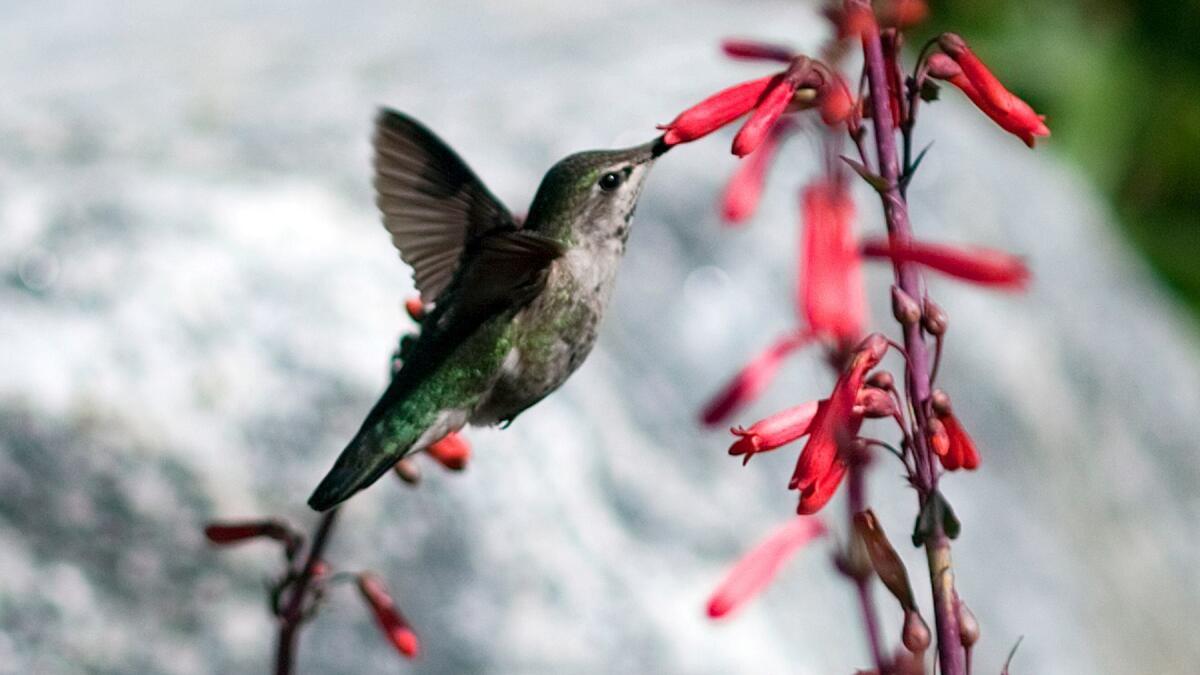Science explains why humans may never see the world through a hummingbird’s eyes

Scientists have revealed that hummingbirds process visual cues in a way that may be unique in the animal kingdom, according to a study published Jan. 5 in Current Biology. (Jan. 6, 2017)
Hummingbirds donât see the world like you or me.
And it turns out they donât see it in the same way as any other known bird, mammal or reptile, either.
In a study published Thursday in Current Biology, scientists reveal that the humming birdâs pea-sized brain processes visual cues in a way that may be unique in the animal kingdom.
This doesnât necessarily mean that when a hummingbird flies through a garden the plants look different to it than they do to us, explains lead author Andrea Gaede, a post-doctoral fellow in the department of zoology at the University of British Columbia.
Instead, her research shows that the hummingbirdâs brain has evolved to respond to motion in a different way than other vertebrates.
Thatâs actually not a huge surprise. After all, as anyone with a hummingbird feeder knows, these buzzing, fairy-like creatures donât move through the world like any other animal, bird or not.
âThe way they maneuver is definitely distinct,â Gaede said. âThere are a few other birds that transiently hover, but generally most birds are just forward fliers.â

In general, flying birds occupy a more 3-dimensional space than those of us who are stuck walking on solid ground. But even among its avian cousins, the hummingbird is special.
Hummingbirds have two unusual flight behaviors. They are hovering experts, and during the mating season males will perform what is known as a courtship dive. They fly high in the sky and then dive through the air at a breakneck speed to get the attention of a female.
Studies have shown that hummingbirds have an enlarged lentiformis mesencephali (LM) compared with other birds. This is a region of the bird brain that usually responds to motion going from back to front. For example, if you slipped on an icy sidewalk and fell backward, the neurons in the part of your brain that corresponds to the LM in birds would start firing like crazy.
(Other parts of the brain are responsible for responding to motion coming from different directions.)
Earlier work has also revealed that the LM is slightly enlarged in avian species that hover for a second or two, but not nearly as much as in the brains of hummingbirds, which exhibit sustained hovering. Therefore, scientists have hypothesized that the enlargement of the LM might be important for stabilization, making it worthy of deeper study.
Thatâs where Gaede and her colleagues in the Altshuler Lab at UBC came in.
âIn my side of the lab we are interested in how visual signs that birds receive during flight are interpreted in the brain, and ultimately how those are transformed to guide flight,â she said.
To learn more about the LMâs role in how hummingbirds perceive the world, Gaede anesthetized six hummingbirds and did a little brain surgery that allowed her to listen to individual neurons in the LM part of the brain.
Next, she showed the birds a computer screen with a field of black dots on a white background. She also created a computer program that moved the dots as a collective unit in eight different directions.
She expected that the neurons in the LM would fire rapidly as the dots moved forward, and calm down when the dots moved backward.
But thatâs not what happened.
Instead, she reports that each neuron in the LM had a preferred direction â meaning it fired more when the dots moved one way rather than another â but there was not an overall bias toward forward motion. Some of the LMs preferred backward motion. Others downward motion. Others upward motion.
When she tried the same experiment with zebra finches, more than half of the neurons in their LMâs had a preference for forward motion as she anticipated.
So, what does that mean?
Mostly it means that hummingbirds are processing motion in a different way than zebra finches and almost every other known animal. And, because of the hummingbirdâs unusual flight patterns, it is likely that this alternative processing evolved to help these birds stabilize while hovering. It might also be useful for flying in a cluttered environment â like a field of flowers.
âThis could be a shortcut, or a sidestep to some other processing, so they are faster at responding to some types of motion,â she said. âItâs definitely different than what has previously been described.â
Gaede added that there is still more work to be done to show how the hummingbird brain is specialized for its specific type of flight.
See the most-read stories in Science this hour Âť
âNow that we know LM functions differently, we want to know if other areas of the brain that the LM interacts with behave differently and how important that is during flight,â she said.
Eventually, this work could help engineers design robots or drones that use the brain processes of the hummingbird to flyâ or at least hover and dive more effectively.
We may never be able to see for ourselves how hummingbirds interpret the world, but perhaps one day, our machines might.
Do you love science? I do! Follow me @DeborahNetburn and âlikeâ Los Angeles Times Science & Health on Facebook.
MORE IN SCIENCE
Seven science stories we canât wait to follow in 2017
Cheetahs are experiencing alarming declines and should be listed as endangered, scientists say
Obesity and sedentary behavior: Which is chicken, which is egg?







